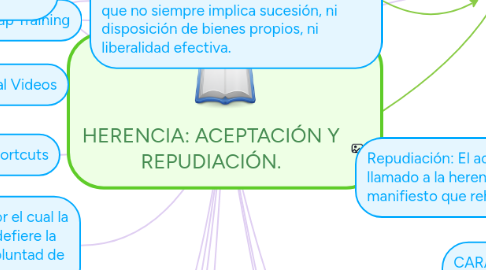
1. Mind Map Training
1.1. Visit the MindMeister Academy to learn all the tricks and become a great mapper in no time!
2. Tutorial Videos
2.1. With our short tutorial videos you can get to know MindMeister's most important features in a matter of minutes
3. Key Shortcuts
3.1. To view the most important shortcuts, click on the question mark in the bottom right corner of your map editor, then click "Key Shortcuts"
4. Mobile Apps
4.1. Download our native mobile apps for iOS and Android to mind map on the go!
5. Stay in the Know
5.1. Follow our blog to never miss an important update, downtime warning or tutorial!
6. Aceptación: Es el acto por el cual la persona a cuyo favor se defiere la herencia manifiesta su voluntad de aquirirla.
7. Legado: La atribución patrimonial mortis causa a titulo singular y ordenada en testamento, pero teniendo en cuenta que no siempre implica sucesión, ni disposición de bienes propios, ni liberalidad efectiva.
8. EFECTOS: 1.- Hace que la herencia deje de ser yacente, 2.- Evita el repudio de la herencia de quien ya la ha aceptado, 3.- Convierte al aceptante en heredero y en titular de la masa hereditaria, 4.- Permite la inscripción del heredero en el Registro Público de la propiedad.
9. CARACTERÍSTICAS: 1.- Es un acto jurídico unilateral, 2.- Es libre de cualquier vicio de voluntad: violencia, dolo o errror, 3.- Es pura y simple, 4.- Es irrevocable, sin embargo cuando en un testamento desconocido se altera la cantidad o calidad de la herencia, pierde esta característica. (Art. 1567, 1568, 1569), 5.- Es retroactiva: los efectos se producen desde la muerte del cujus. (Art. 1557), 6.- Sin término legal, 7.- Puede ser expresa o tácita (Art. 1553), 8.- Es indivisible, 9.- Es impugnable en los casos de: dolor, error y violencia (Art. 1567), 10.- Se entiende siempre a beneficio de inventario (Art. 1579), 11.- Debe hacerse por los acreedores, previa autorización judicial, cuando el repudio de la herencia va en su prejucio (Art. 1570).
10. CLASES DE LEGADO: 1.- Legados reales y obligacionales, 2.- Voluntarios por su orígen, 3.- Por sus modalidades pueden ser puros, condicionales, modales, 4.- Por la forma de manifestarse la voluntad del testador, pueden ser legados expresos y tácitos, 5.- Por su regulación pueden ser típicos, 6.- Por su objeto pueden existir tantas clases de legados como cosas o derechos puedan ser objeto de aquellos.
11. By the way, this is a floating topic. To create a floating topic, simply drag it away from the map center.
12. Getting started
12.1. Add a sibling idea by hitting ENTER
12.2. This is a sibling idea
12.3. Add a child idea by hitting TAB
12.3.1. This is a child idea
12.4. Choose icons and images to decorate your mind map
12.5. Connect topics with the arrow tool in the upper left corner of your screen
12.6. Add links, tasks or files to your topics, using the widgets in the sidebar
12.7. Change your map layout by opening the layout options in the upper left corner of your screen
12.8. Advanced
12.8.1. Open the Theme menu from the bottom of your map editor to change your map theme
12.8.2. Create a presentation of your mind map by clicking the presentation icon in the bottom left corner of your screen
12.8.2.1. Simply hold down COMMAND i.e. CTRL and Click & Drag to create a slide for one or multiple topics
12.8.2.2. Set transitions for your slides
12.8.2.3. Click "Start Slideshow" to view your presentation
12.8.3. Open the Sharing Settings from the bottom of your map editor to share the map with a friend or publish it to the web
12.8.3.1. You can share your map with anyone via email
12.8.3.2. You can publish your map and enable anyone with an internet access to find it
12.8.3.3. You can embed your map on a blog or website
